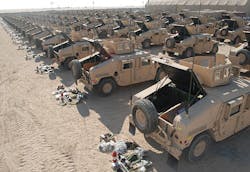Is the military drawdown happening too fast and at the wrong time?
What got me thinking were a couple of contracts awarded late last week collectively worth more than one-third of a billion dollars to get rid of conventional munitions the U.S. military no longer needs.
This process, known as conventional munitions demilitarization, is nothing new. It involves the industrial-level dismantling, recycling, and disposal of military munitions that have become surplus, obsolete, or both.
What hit me, however, is the large size of the munitions-demilitarization contracts; no other conventional munitions-demilitarization contracts the military has awarded over the past 20 years have come even close.
Related: Army launches biggest project in past 20 years to dispose of surplus and obsolete munitions
At the same time, some military vehicles are being brought back to the States for long-term storage, where it's unlikely they ever will see action again. Relatively new armored combat vehicles have been sold for scrap in Afghanistan because it's far cheaper to see them destroyed in theater than it would be to bring them home.
What's all this mean? I think it's obvious that the Army is drawing down its stocks of vehicles, bullets, bombs, mortars, artillery rounds, and other explosive weapons. It's understandable, since active Army operations in Afghanistan, Iraq, and other areas of Southwest Asia are coming to a close.
Perhaps it's an opportunity for the Army to clear out legacy munitions to make room for more modern weapons like the M982 Excalibur satellite-guided heavy artillery shell from Raytheon Missile Systems in Tucson, Ariz., and the Roll Control Guided Mortar (RCGM) GPS-guided 120-millimeter mortar round from the General Dynamics Corp. Ordnance and Tactical Systems segment in St. Petersburg, Fla.
Later this year, moreover, the Army is set to award a big production contract for the Joint Light Tactical Vehicle (JLTV) to replace Humvees have been in service for more than 30 years. The U.S. military wants to buy 54,599 JLTVs -- 49,099 for the U.S. Army and 5,500 for the U.S. Marine Corps -- at a cost of more than $53.3 billion.
Related: A U.S. military stuck in the ditch
Making way for more modern munitions certainly isn't the only reason that the Army might be drawing down its stocks of conventional munitions. Rotating out old munitions is an often-crucial process to get rid of military explosives that can become dangerously unstable over time.
The Army has a continuous process of inspecting stored munitions to ensure their reliability, and to weed out those of questionable reliability.
These all are solid reasons for demilitarizing munitions stocks and phasing out legacy military vehicles. Still, the world remains a dangerous and unstable place. The militant Islamic group ISIS is on the march in Iraq and Syria, filling the power vacuum left by the U.S. military pullout.
Iran, meanwhile, inches closer to developing nuclear weapons, and farther east, China is flexing its military muscles in the South China Sea by building military bases and airfields on previously uninhabited reefs.
I'd hate to see a U.S. military drawdown happen too quickly, and at the wrong time.
